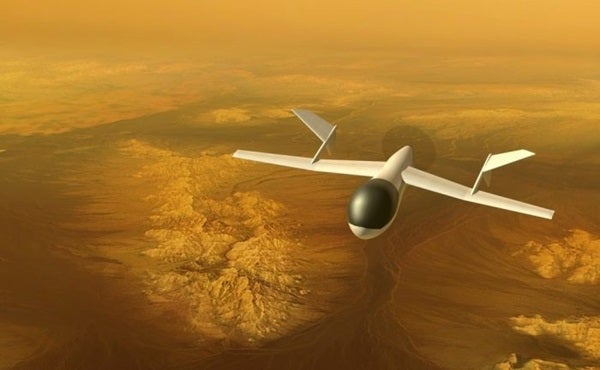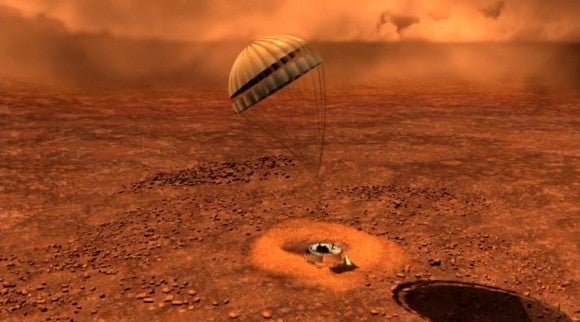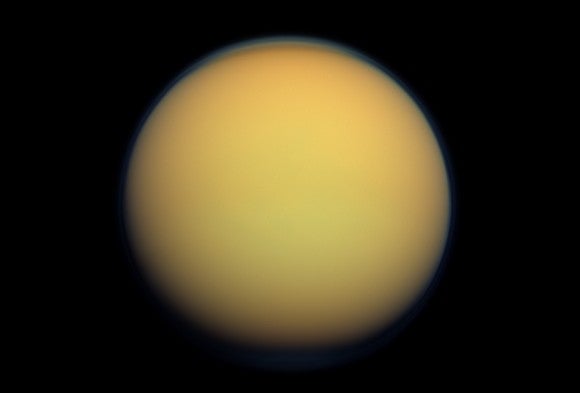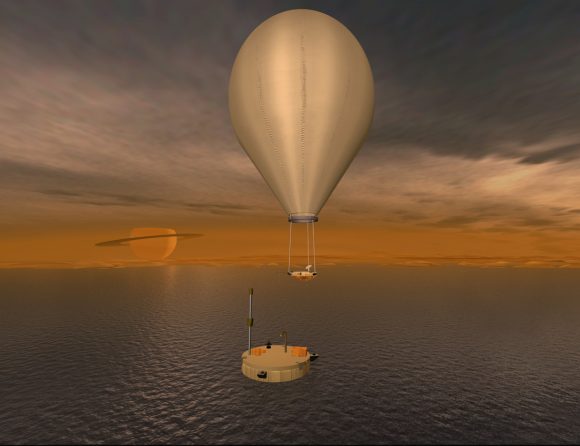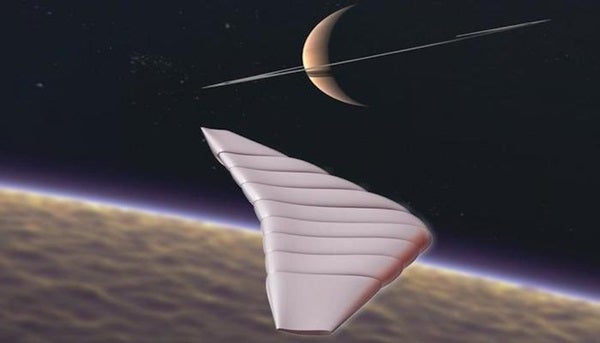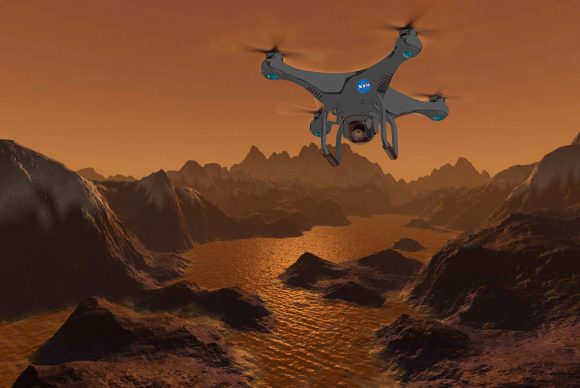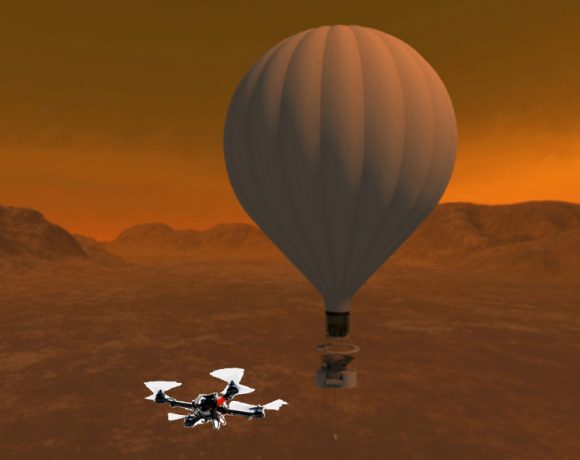This article originally appeared on Universe Today.
Last week, from Monday Feb. 27th to Wednesday March 1st, NASA hosted the “Planetary Science Vision 2050 Workshop” at their headquarters in Washington, DC. During the course of the many presentations, speeches and addresses that made up the workshop, NASA and its affiliates shared their many proposals for the future of Solar System exploration.
A very popular theme during the workshop was the exploration of Titan. In addition to being the only other body in the Solar System with a nitrogen-rich atmosphere and visible liquid on its surface, it also has an environment rich in organic chemistry. For this reason, a team led by Michael Pauken (from NASA’s Jet Propulsion Laboratory) held a presentation detailing the many ways it can be explored using aerial vehicles.
The presentation, which was titled “Science at a Variety of Scientific Regions at Titan using Aerial Platforms“, was also chaired by members of the aerospace industry – such as AeroVironment and Global Aerospace from Monrovia, California, and Thin Red Line Aerospace from Chilliwack, BC. Together, they reviewed the various aerial platform concepts that have been proposed for Titan since 2004.
While the concept of exploring Titan with aerial drones and balloons dates back to the 1970s and 80s, 2004 was especially important since it was at this time that the Huygens lander conducted the first exploration of the moon’s surface. Since that time, many interesting and feasible proposals for aerial platforms have been made. As Dr. Pauken told Universe Today via email:
“The Cassini-Huygens mission revealed a lot about Titan we didn’t know before and that has also raised a lot more questions. It helped us determine that imaging the surface is possible below 40-km altitude so it’s exciting to know we could take aerial photos of Titan and send them back home.”
These concepts can be divided into two categories, which are Lighter-Than-Air (LTA) craft and Heavier-Than-Air (HTA) craft. And as Pauken explained, these are both well-suited when it comes to exploring a moon like Titan, which has an atmosphere that is actually denser than Earth’s – 146.7 kPa at the surface compared to 101 kPa at sea level on Earth – but only 0.14 times the gravity (similar to the Moon).
“The density of Titan’s atmosphere is higher than Earth’s so it is excellent for flying lighter-than-air vehicles like a balloon,” he said. “Titan’s low gravity is a benefit for heavier-than-air vehicles like helicopters or airplanes since they will ‘weigh’ less than they would on Earth.”
TSSM Montgolfiere Balloon:
Plans for using a Montgolfiere balloon to explore Titan go back to 2008, when NASA and the ESA jointly developed the Titan Saturn System Mission (TSSM) concept. A Flagship Mission concept, the TSSM would consist of three elements including a NASA orbiter and two ESA-designed in-situ elements – a lander to explore Titan’s lakes and a Montgolfiere balloon to explore its atmosphere.
The orbiter would rely on a Radioisotopic Power System (RPS) and Solar Electric Propulsion (SEP) to reach the Saturn system. And on its way to Titan, it would be responsible for examining Saturn’s magnetosphere, flying through the plumes of Enceladus to analyze it for biological markers, and taking images of Enceladus’ “Tiger Stripes” in the southern polar region.
Of the benefits to this concept, the most obvious is the fact that a Montgolfiere vehicle powered by RPS could operate within Titan’s atmosphere for many years and would be able to change altitude with only minimal energy use. At the time, the TSSM concept was in competition with mission proposals for the moons of Europa and Ganymede.
In February of 2009, both the TSSM and the the Europa Jupiter System Mission (EJSM) concept were chosen to move forward with development, but the EJSM was given first priority. This mission was renamed the Europa Clipper, and is slated for launch in 2020 (and arriving at Europa by 2026).
Titan Helium Balloon:
Subsequent research on Montgolfiere balloons revealed that years of service and minimal energy expenditure could also be achieved in a much more compact balloon design. By combining an enveloped-design with helium, such a platform could operate in the skies of Titan for four times as long as balloons here on Earth, thanks to a much slower rate of diffusion.
Examples of the this include the Titan Winged Aerobot (TWA, shown below), which was investigated as part of NASA’s Phase One 2016 Small-Business Innovation Research (SBIR) program. Developed by the Global Aerospace Corporation, in collaboration with Northrop Grumman, the TWA is a hybrid entry vehicle, balloon, and maneuverable glider with 3-D directional control that could satisfy many science objectives.
Like the Mongtolfiere concept, it would rely on minimal power provided by a single RPS. Its unique buoyancy system would also allow it to descend and ascend without the need for propulsion systems or control surfaces. One drawback is the fact that it cannot land on the moon’s surface to conduct research and then take off again. However, the design does allow for low-altitude flight, which would allow for the delivery of probes to the surface.
Other concepts that have been developed in recent years include heavier-than-air aircraft, which center around the development of fixed-wing vehicles and rotorcraft.
Concepts for fixed-wing aircraft have also been proposed in the past for a mission to Titan. A notable example of this is the Aerial Vehicle for In-situ and Airborne Titan Reconnaissance (AVIATR), an unmanned aerial vehicle (UAV) that was proposed by Jason Barnes and Lawrence Lemke in 2011 (of the University of Idaho and Central Michigan University, respectively).
Relying on an RPS that would use the waste heat of decaying Plutonium 238 to power a small rear-mounted turbine, this low-power craft would take advantage of Titan’s dense atmosphere and low gravity to conduct sustained flight. A novel “climb-then-glide” strategy, where the engine would shut down during glide periods, would also allow for power to be stored for optimal use during telecommunication sessions.
This addresses a major drawback of fixed-wing vehicles, which is the need to subdivide power between the needs of maintaining flight and conducting scientific research. However, the AVIATR is limited in one respect, in that it cannot descend to the surface to conduct science experiments or collect samples.
Rotorcraft:
Last, but not least, is the concept for a rotorcraft. In this case, the aerial platform would be a quadcopter, which would be well-suited to Titan’s atmosphere, would allow for easy ascent and descent, and for studies to be conducted on the surface. It would also take advantage of developments made in commercial UAVs and drones in recent years.
Currently, NASA’s Jet Propulsion Laboratory is developing a similar concept, known as the Mars Helicopter “Scout”, for use on Mars – which is expected to be launched aboard the Mars 2020 mission. In this case, the design calls for two coaxial counter-rotating rotors, which would provide the best thrust-to-weight ratio in Mars’ thin atmosphere.
Another rotorcraft concept is being pursued by Elizabeth Turtle and colleagues from John Hopkins APL and the University of Idaho (including James Barnes). With support from NASA and members of Goddard Space Flight Center, Pennsylvania State University, and Honeybee Robotics, they have proposed a concept known as the “Dragonfly“.
Their aerial vehicle would rely on four-rotors to take advantage of Titan’s thick atmosphere and low gravity. Its design would also allow it to easily obtain samples and determine the composition of the surface in multiple geological settings. These findings will be presented at the upcoming 48th Lunar and Planetary Science Conference – which will be taking place from March 20th to 24th in The Woodlands, Texas.
With every potentially life-bearing body we explore, we stand to learn more about how life began in our Solar System. And even if we do not find any life in the process, we stand to learn a great deal about the history and formation of the Solar System. On top of that, we will be one step closer to understanding humanity’s place in the Universe.
Further Reading: USRA

